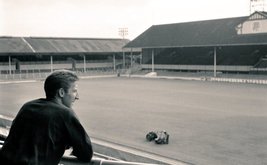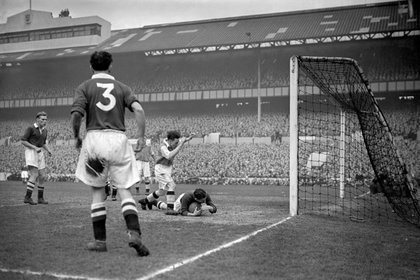 The latest chapter in our salute to White Hart Lane takes us back to the east side of the ground. Danny Blanchflower once talking about the Shelf said how opposition teams coming out of the tunnel faced that massive stand with its white frame and the roar of the crowd echoing back off the wall must have been intimidating. Even Cliff Jones spent time on the Shelf. The ground was never quite the same once the Shelf disappeared. A view shared by the great Jimmy Greaves who said a few years back how he felt the ground lost some of its soul when the Shelf was replaced and fans made to sit down. He said he hoped when the new ground is built they find a way to lock that sound in and not let it escape to the heavens.  Steve Perryman agreed and called the fans on the Shelf, fanatics and the spirit of Spurs. That’s how it felt in those long gone, never forgotten days, if by screaming just a little louder and willing our passion towards the feet of the Lilywhite with the ball helped the cause or that ‘come on you Spurs’ distracted the enemy then so be it. Even if on occasion the way home was undertaken in silence and sign language as your vocal cords recovered. Not to mention the palms of your hands still throbbing where you had relentlessly slapped the wooden barrier in time with the clapping rhythms of the chants. Having watched the Spurs from every aspect of the ground over the years, The Shelf and the Park Lane always seemed to ‘up the volume’ compared to the West Stand. I know season ticket holders of many years sitting in that area who would agree.  Above the Lane under snow during the 1980's. Right - Training at the Lane in 1956. Another Lilywhite legend who ‘felt the force’ was Steve Archibald, “The Shelf was something extra special, hail, rain or snow always there and always pushing us on, brilliant support.” The clubs FA Cup triumph in 1921 had brought in welcome finances. Whilst the fans clammed for transfers the Directors spent much of it on improving the ground. Whether they got the balance right is for you to decide, (1). It is a fact that the club entered a poor time on the pitch as we revealed previously. In addition to purchasing the Red House and converting it from a restaurant into offices. Archibald Leitch was called in again and this time he turned his attention to the Paxton/Edmonton end to create a split level covered terrace.  Two years later he repeated the same at the Park Lane / Marsh Lane end. This increased the capacity of the ground to 58,000. And as the programmes of the time will proudly inform you, 40,000 under cover. The next major development came as Tottenham returned to the First Division at the end of the 1933 /34 season. Once again Leitch was employed and this time it was his piece-de-resistance. The famous East Stand. The tallest stand in the country at one time. It added over five thousand seats and a massive 18,700 standing. 11,000 on them on the upper half of the split level terracing. The Shelf was born. Left - The East Stand and below From the west side in 1965  Described as the best terraced view of football in the land. The grounds capacity was now officially 80,000, although the record stands at 75.038. The build cost £60,000. That was equal to the total profits that the club had made since the end of World War One. Even if you feel the Directors played ‘too safe’ in regard to the playing staff you can see the ambition was there. The best season financially in that time was 1921/22 when the club reported a profit of £17,417. The season the stand opened (34/35) the profit was just £8,777. It was officially opened for the visit of Aston Villa on September 22nd 1934.  Numerous views of the East Stand in its construction and since are including when it was painted green appear throughout this series. There is also a lovely description of the Shelf included in The East Side, In case your wondering why I've included a picture of 1950's Cup semi-final Arsenal V Chelsea. They have met twice at The Lane in semis and both went to replays so that's four games. If you look up on the roof you will some people sitting there. Check out the other articles celebrating White Hart Lane at http://www.indiaspurs.com/blog
The White Harts Ground, Rowels Park, The High Street Ground, Gilpin Park, The Ring, The Edmonton End, The Marsh Lane End, Hotspur Towers 58, 33, 16 and 5. Hotspur Towers 50 - The Cockerel, Hotspur 46 - Ground Sharing, Talking Tottenham - At The Lane, White Hot Lane, Come All Ye Faithful. COYS Keith Harrison. t- Keith 16024542 f- https://www.facebook.com/keith.harrison.9659 You can my full archive at - View Full Bio As well as the Milestones series running on Face book this season, link above. Notes – 1 – The Roaring 20’s and the Forgotten Years these mini series start at - http://www.indiaspurs.com/blog/ht36-tottenham-and-the-roaring-20s-part-1 and - http://www.indiaspurs.com/blog/hotspur-towers-the-forgotten-years-part-1
0 Comments
Leave a Reply. |
Features
Flying Down to Rio History of T.H.F.C. Tribute to Bill Nicholson Talking Tottenham Early Legends The Road to Turin International Connections Hotspur Towers Most Read Articles
The 100 Year War Interview with Marina Sirtis A Long Dark Shadow By Royal Appointment School Report: An Insight into the Younger Eric Dier Dear Jimmy All Change At Spurs Hotspur Towers History Of THFC: Part 1 Passage to India: Rohan Rickets Thanks For The Memories Our Tommy Carroll The AVB Files: Part1 The Lilywhites You The Jury The Hand Of Hugo Connection - Argentina Creating a Reputation One Hotspur Archives
August 2018
Categories
All
|
 RSS Feed
RSS Feed

